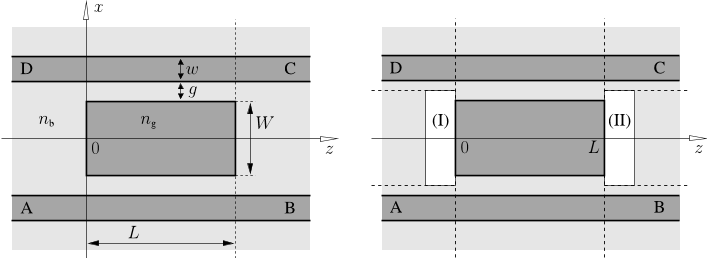




Did you find this useful? Give us your feedback





![FIGURE 16. Extremal field profiles around the facet of a multimode waveguide with the parameters of the cavity of Figure 12, for an excitation by individual modes of order 6 (left) and 8 (center), and for a specific superposition of these two incoming fields (right). Rigorous BEP simulations [13] predict relative power fractions of 79% (TE6), 78% (TE6), and 99.3% (TE6 + TE8) that are reflected into the incoming fields.](/figures/figure-16-extremal-field-profiles-around-the-facet-of-a-imq9byfm.png)





![FIGURE 12. Field pattern for the pronounced resonance in Figure 11 at λ = 1.55 µm, extremal snapshots of the single electric y-component of the TE fields, at times t equally distributed over one period T . The rigorous simulation from [13] predicts relative power transmissions of PA = 24.4%, PB = 25.5%, PC = 24.5%, and PD = 24.2%.](/figures/figure-12-field-pattern-for-the-pronounced-resonance-in-ecqfxskr.png)







359 citations
95 citations
51 citations
47 citations
43 citations
...[19, 31] can be applied, that predict a symmetric scattering matrix....
[...]
359 citations
272 citations
127 citations
...Manifold variants of coupled mode theory have been proposed, for a variety of different domains of applications [19, 15, 20, 4]....
[...]
60 citations
Disregarding its influence on the performance of the (short) couplers as a first approximation, a tuning mechanism, modeled by a small parameter p, affects mainly the light propagation along the cavity ring.
The two facets at the ends of the cavity segment cause strong reflections of the waves that are excited inside the cavity, while one can assume that they have much less influence on the waves that travel along the port cores.
As expected, in general the net power transfer between the straight and the bend core grows with decreasing gap width, i.e. with increasing interaction strength, and with increasing bend radius, i.e. with increasing interaction length.
(3)(The approximate constraint of lossless couplers requires |ρ|2 + |κ|2 = 1 and |κ|2 + |τ|2 = 1, consequently |ρ|2 = |τ|2 = 1 − |κ|2. Provided the input- and output planes are placed properly, one can even restrict to ρ = τ .
According to the former quantitative characterization in terms of amplification factors based on eigenvalues of Ω, high quality resonances in a dielectric rectangle require a facet reflectivity close to unity for the contributing cavity modes.
While this refers to a single mode resonance with a field based upon only one (forward and backward propagating) mode per axis, a bimodal resonance is characterized by the existence of a pair of modes per axis orientation that satisfy the phase relations simultaneously.
Due to the additional symmetry of the coupler element with respect to the vertical plane z = 0 one can expect the transmission A+ → b+ to be equal to the transmission B− → a−.
If additionally the radius of the bent core is increased (bottom), one arrives at a configuration with a coupling coefficient |κ|2 that is almost equal to the one of the structure at the top, i.e. the couplers effect similar levels of power transfer between the straight and the bend waveguide, despite the fact that the strength as well as the length of the interaction is much larger in the bottom configuration with larger bend radius andsmaller gap width.
Hence the proper way to compute the resonator spectrum would be to evaluate the properties of the port waveguides, the cavity segments, and of the coupler regions as input for the above expressions, for a series of wavelengths.
R (though one frequently encounters the approximation L = 2πR corresponding to an interaction length that is short when compared to the cavity ring).